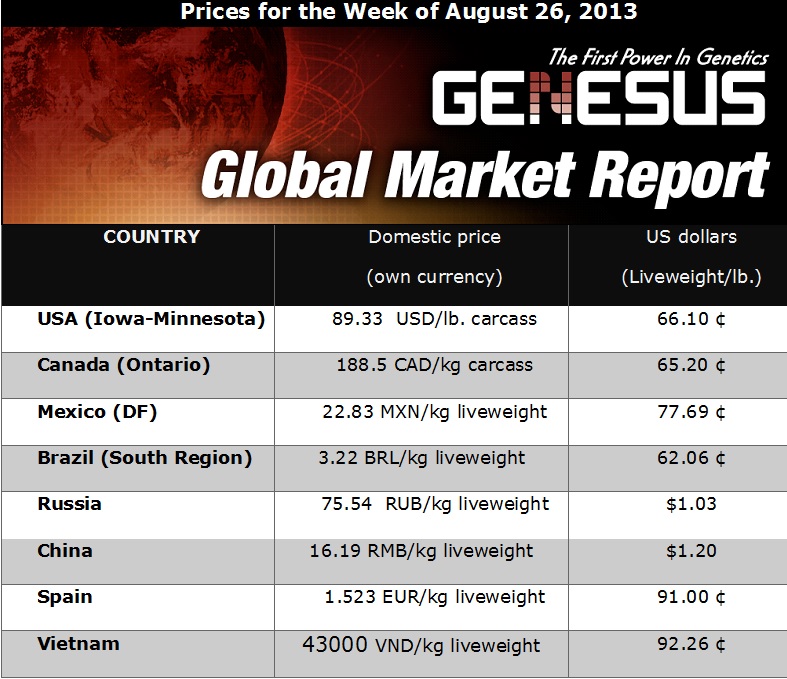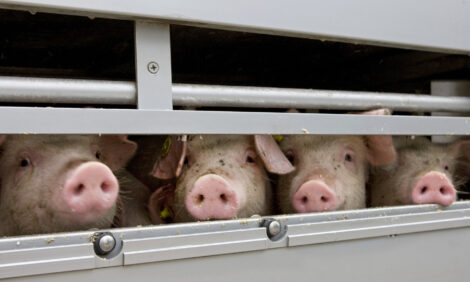



Viet Nam: Hog Markets
VIET NAM - The first six months of 2013 has been very difficult for swine producers. The rise in fuel costs, disease challenges and production costs - mainly due to increased feed ingredients costs, coupled with low market pig prices - have seen most farmers show losses during this time period, writes Fernando Ortiz.Farmers are seeing financial stress and have little incentive to invest in their farms (several farms are closing down or reducing their sow herd). Also the blue ear disease (PRRS) has occurred in many provinces. Currently, an outbreak of PRRS in Dak Lak province is noted.
The estimated total number of pigs in the Country on June 15/2013 was 26.5 million- a drop of 0.52 per cent compared to the same period in 2012. July saw a further drop in the total number of pigs in the Country.
July 2013 total number of pigs is down 1.5 per cent from July 2012. A recent survey done by the General Statistics Office at the beginning of April, showed the estimated total number of pigs to be 26.98 million, an increase of 1.08 per cent compared to April, 2012. The total number of sows was 15.43 per cent of the 26.98 million total pigs or 4.16 million sows. Sow numbers for July are flat similar to last month.
Recently, the market price has been rising to return to a profitable level for farmers. In the first 6 months of 2013, the market price has been many times below the production costs and thus farms have showed unprofitable or less profitable cash flows. Market pig prices were: January, 48,000 VND/kg ($2.26US/kg-$1.03US/lb.)(north region) and 44,500 VND/kg ($2.10 US/kg-$0.95US/lb.) (south region); in March, 43,000 VND/kg ($2.03US/kg-$0.92/lb.)(north region) and 38,000 VND/kg ($1.79US/kg-$0.81US/lb.)(south region); and in May, 41,000 VND/kg ($1.93US/kg-$0.88US/lb.)(north region) and 37,500 to 39,000 VND/kg-$1.77US to $1.84US/kg-$0.80US to $0.83/lb.) (south region). Currently, the south region has market prices of 40,000 to 41,000 VND/kg ($1.89US/kg-$0.86US/lb. to $1.94US/kg-$0.88US/lb.).
General Statistics Office has released the consumer price index (CPI) for July and it increased by 0.27 per cent from the previous month. July CPI has increased by 6.81 per cent (year on year as compared to July 2012) and increased by 2.68 per cent since December 31st, 2012. For June, the CPI increased by 0.05 per cent from May. June CPI has increased by 6.69 per cent (year on year as compared to June 2012) and increased 2.4 per cent since December 31st, 2012.
The most notable change in the prices for July was the food items. After 4 months of continuous decline since the Lunar New Year, the food price index rose 0.18 per cent from the previous month (food will be the index that the Government will show the most interest in for price movements in the remaining months of this year).
The increase of 0.18 per cent for food price index also factors into the 1.82 per cent increase for the first seven months of 2013.Compared to the price index of manufacturing products such as agriculture, forestry and fisheries, the price of livestock products such as pork, cattle and aquaculture products are below or increased less than the increase in the general CPI index. Livestock products such as pork, beef, and chicken are still down nearly 10 per cent over the previous year. This huge gap reinforces the argument that farmers are suffering losses with the current market price situation.
For the first seven months of 2013, Viet Nam ’s imports for feed ingredients (mainly corn, wheat and soybeans) plus prepared animal feeds jumped 37.6 per cent year on year to a value of $1.77 billion USD.
Nearly 1.12 million tonnes of corn (an increase of 12.9 per cent and with an estimated value of $366.52 million USD) was imported during the first seven months of 2013. In addition, 861,920 tonnes of soybeans, with a value of $524.04 million USD (an increase of 2.6 per cent in volumne-year on year) were brought into the country. A comment was made that because of the strong dependence on imported animal feeds and ingredients, the price of animal feeds in Viet Nam is 20 to 30 per cent higher than surrounding countries that rely less on imports.
Recent information for August shows that for the first eight months, Viet Nam spent $2.09 billion USD on imports for feed and feed ingredients (importing 1.08 million tonnes of wheat; 1.34 million tonnes of corn and 897,000 tonnes of soybeans).
Nguyen Tri Cong, Chairman of Dong Nai's Livestock Association (with about 1,600 members) reported that exports to China from his province has boosted local market pig prices around Ho Chi Minh City. Currently, market pigs are sold from 42,670 to 43,670 VND/kg ($2.02US to 2.07US/kg-$0.92US to $0.94US/lb.). This is an increase from last month (July2013) of $0.09US to $0.14US/kg-$0.04US to $0.06US/lb.).
Mr Au Thanh Long, Chairman of Duy Cuong Breeding Company (Dong Nai province) stated that due to the economic downturn, there has been a surplus of livestock by more than 20 per cent - 30 per cent . Supply exceeds demand and product prices are lower than production costs. Therefore, the current resolution of the total output of livestock inventory cannot be solved by the domestic consumption only, but needs an expanding export business. The value for export by Viet Nam is at a standstill due to the diseases found throughout the region. Right now, Viet Nam can rely only on the market sale quota via China. According to the farmers, pork exports into China do not need good quality.
In contrast, traders are choosing to buy pork, with high pork fat percentage. (In Viet Nam , there are plenty of farms with these types of market pigs). Mr Phuc, a restaurant owner from Mong Cai (found in QuangNinh province and near the Chinese border) has three trucks with three decks and they are collecting market pigs in the Dong Nai area. The market price for the pig or the difference in price in China versus the local farms is 10,000 VND/kg-$0.47US/kg-$0.21/lb.
This level, after deducting the costs: trucking costs, fuel costs, quarantine fees and road fees, shippers like Mr Phuc can earn 2,000 VND to 5,000 VND/kg ($0.09US to $0.24US/kg-$0.04 to$0.11/lb.). Local farmers like the current upward trend in market price, but they fear that the China border may close or the Chinese will find supply from within their own country or from other Country’s sources.
Information from Viet Nam Animal Feed Association and the Ministry of Agriculture and Rural Development, project that the cost per tonne of imported soybeans is declining. For August, the price was about $ 610US/tonne; for September it is estimated to be about $563US/tonne and for October the estimate is lowered to $516US/tonne.










